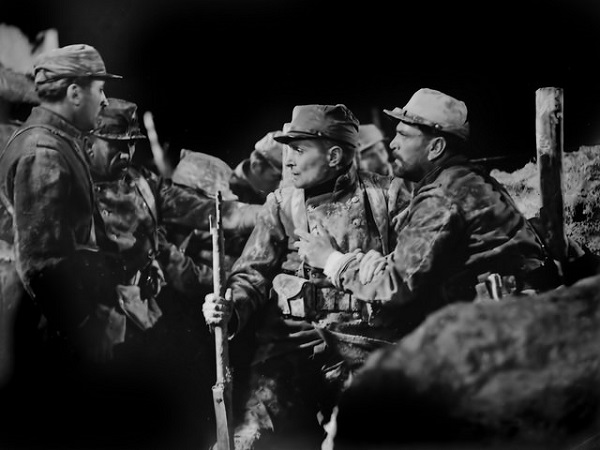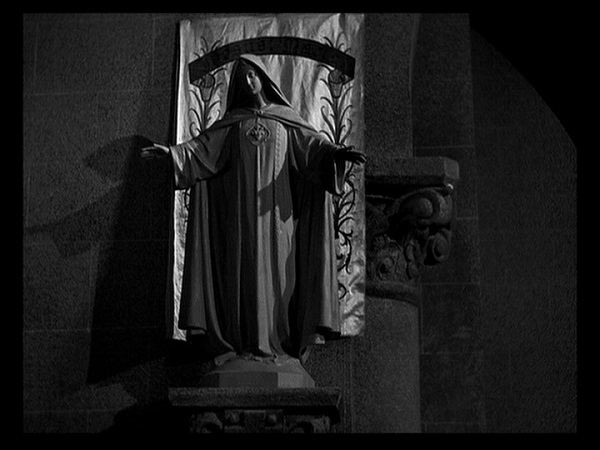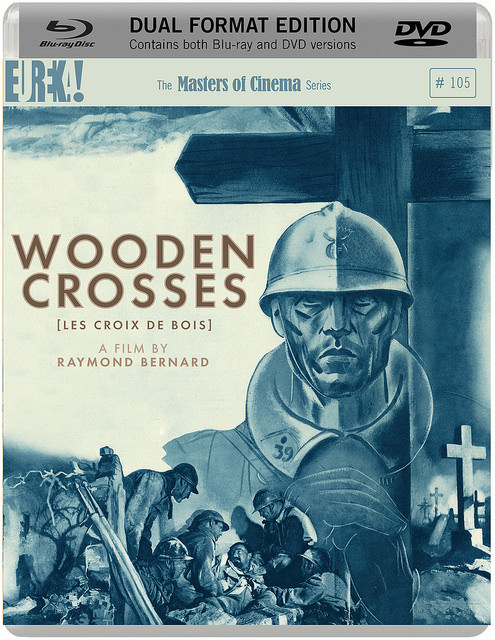Masters of Cinema Blu-ray Review: Wooden Crosses
"The re-release of forgotten French war movie"
The French First World War movie
Wooden Crosses (
Les Croix de Bois) from legendary director Raymond Bernard is the latest re-release from Eureka Entertainment for their Masters of Cinema series.
During the early days of World War I Germany has invaded France and men around the country sign up to join the army. One man is Gilbert Demachy (Pierre Blanchar), a law student who ends up being a part of 3rd Squad of the 3rd Division in the 39th Regiment. Despite the early hopes that the war would be won in months, the conflict and trench warfare grinds on and Gilbert slowly starts to lose comrades.

Bernard was a veteran of the war and so were many of the actors. He sets out his stall very early during the movie with the credits being superimposed on a burning memorial and following it with soldiers standing in formation before turning into row after row of crosses. These themes continue with the increasing body court, the muddy environments of the trenches and the extremely spartan sleeping conditions. Add to that, the constant noise of the frontlines, the generals not understanding the reality of the frontline and a sequence where a soldier is begging for help as he lies dying in No Man's Land.
When Gilbert joins the squad as a raw recruit, his uniform is fully buttoned and professional. The rest of his squad have already fought in war and are much more causal in their dress, and have had success pushing back the Germans. We are introduced to the soldiers as a jovial bunch who sing and drink and we get to know their personalities. But as the reality of war takes hold, the squad becomes more weary and jaded about the war.
Bernard focuses on both the horrors of fighting the war and the more mundane action of being a soldier. It was at the hour mark when the big battle of the movie happens, a ten-day long event where the French assault the Germans, going through a ruined village before it turned into a defensive battle for the French troops. Artillery is raining down on the battlefield as explosions happen all around and soldiers charge towards the Germans. Bernard uses tracking shoots during the early charge and handheld cameras during the thick of the battle: it is very impressive for a movie made in 1932, a precursor to
Saving Private Ryan. It is a sequence that lasts for 25 minutes. But the warfare is a bloodless affair which is disappointing considering that the American version of
All Quiet on the Western Front was pretty graphic for its time and released two years earlier.

Talking about
All Quiet on the Western Front,
Wooden Crosses does have similarities to the movie from 1930. Both Gilbert and Paul from
All Quiet on the Western Front are young men who are swept away by patriotic fervor to join the army and develops a close friendship with their respective squads as they become jaded by the war. The troops in
Wooden Crosses are enthusiastic about the war, with soldiers singing love songs as they march to frontlines and the French public cheer them on. The songs become much more muted as as the movie progresses. There are differences between
Wooden Crosses and
All Quiet on the Western Front:
Wooden Crosses is set in 1914,
All Quiet on the Western Front takes place from 1914 until1918 and there are many story and plot points where there are differences. The similarities are of a more general nature between the two movies than one being a copy of the other.
Gilbert and the 3rd Squad are the primary focus of
Wooden Crosses, yet Bernard does allow other themes about the war. In a scene in a church there is a divide between the people worshiping and the severely wounded soldiers on the other side as Gilbert makes a plea to the Virgin Mary.
Wooden Crosses also hints at how the wider world sees the war with troops coming back to the frontline with the public still believing that the war would be over soon. The Germans are briefly looked at, but they are treated as an enemy in the distance, neither good or bad and like the French soldiers doing their duty with one German soldier singing an opera as he is standing watch.

On a technical level
Wooden Crosses is very impressive for the period. As already mentioned, the war sequences were excellent and it was a movie that was experimental with its editing, superimposing images into the background over scenes, highlighting flashbacks and actions of characters and a mood, with a sequence during a parade in a village being overshadowed with wounded soldiers matching up a hill. One particularly powerful sequence is when Gilbert visits the grave of a fallen soldier, which shows the impact of silence to a scene, allowing Gilbert's contemplation to be on display.
Wooden Crosses is an impressive achievement for its time, being a war movie made on a grand scale. The battle sequences are well executed and could easily stand up against sequences in latter movies. It is a triumph for early editing and sound mixing with Bernard and his team putting in the extra effort for the movie to succeed. But
Wooden Crosses is often overshadowed by its contemporary
All Quiet on the Western Front.
 Special Features
Special Features
The Blu-ray comes with a variety of behind the scenes documentaries and historical documentaries. Included are a 32 minute discussion between historian Marc Ferro and film historian Laurent Verat talking about the history of the film and the wider context, a 22 minute documentary about the restoration of film and a quick documentary about the sound. Also included are archived interviews with director Raymond Bernard and novelist Roland Dorgelès. The Blu-ray comes with a 40 page booklet which has an essay from film critic Emmanuel Burdeau, an extract from Bernard's autobiography and reports about the adaptation and restoration of
Wooden Crosses.
Pros
- Excellent war sequences and realistic look at look on the front
- The neutral look at the combatants
- It wide ranging look at wartime issues
- The editing techniques
- Great use of sound
Cons
- A thin narrative and storyline
 Bernard was a veteran of the war and so were many of the actors. He sets out his stall very early during the movie with the credits being superimposed on a burning memorial and following it with soldiers standing in formation before turning into row after row of crosses. These themes continue with the increasing body court, the muddy environments of the trenches and the extremely spartan sleeping conditions. Add to that, the constant noise of the frontlines, the generals not understanding the reality of the frontline and a sequence where a soldier is begging for help as he lies dying in No Man's Land.
When Gilbert joins the squad as a raw recruit, his uniform is fully buttoned and professional. The rest of his squad have already fought in war and are much more causal in their dress, and have had success pushing back the Germans. We are introduced to the soldiers as a jovial bunch who sing and drink and we get to know their personalities. But as the reality of war takes hold, the squad becomes more weary and jaded about the war.
Bernard focuses on both the horrors of fighting the war and the more mundane action of being a soldier. It was at the hour mark when the big battle of the movie happens, a ten-day long event where the French assault the Germans, going through a ruined village before it turned into a defensive battle for the French troops. Artillery is raining down on the battlefield as explosions happen all around and soldiers charge towards the Germans. Bernard uses tracking shoots during the early charge and handheld cameras during the thick of the battle: it is very impressive for a movie made in 1932, a precursor to Saving Private Ryan. It is a sequence that lasts for 25 minutes. But the warfare is a bloodless affair which is disappointing considering that the American version of All Quiet on the Western Front was pretty graphic for its time and released two years earlier.
Bernard was a veteran of the war and so were many of the actors. He sets out his stall very early during the movie with the credits being superimposed on a burning memorial and following it with soldiers standing in formation before turning into row after row of crosses. These themes continue with the increasing body court, the muddy environments of the trenches and the extremely spartan sleeping conditions. Add to that, the constant noise of the frontlines, the generals not understanding the reality of the frontline and a sequence where a soldier is begging for help as he lies dying in No Man's Land.
When Gilbert joins the squad as a raw recruit, his uniform is fully buttoned and professional. The rest of his squad have already fought in war and are much more causal in their dress, and have had success pushing back the Germans. We are introduced to the soldiers as a jovial bunch who sing and drink and we get to know their personalities. But as the reality of war takes hold, the squad becomes more weary and jaded about the war.
Bernard focuses on both the horrors of fighting the war and the more mundane action of being a soldier. It was at the hour mark when the big battle of the movie happens, a ten-day long event where the French assault the Germans, going through a ruined village before it turned into a defensive battle for the French troops. Artillery is raining down on the battlefield as explosions happen all around and soldiers charge towards the Germans. Bernard uses tracking shoots during the early charge and handheld cameras during the thick of the battle: it is very impressive for a movie made in 1932, a precursor to Saving Private Ryan. It is a sequence that lasts for 25 minutes. But the warfare is a bloodless affair which is disappointing considering that the American version of All Quiet on the Western Front was pretty graphic for its time and released two years earlier.
 Talking about All Quiet on the Western Front, Wooden Crosses does have similarities to the movie from 1930. Both Gilbert and Paul from All Quiet on the Western Front are young men who are swept away by patriotic fervor to join the army and develops a close friendship with their respective squads as they become jaded by the war. The troops in Wooden Crosses are enthusiastic about the war, with soldiers singing love songs as they march to frontlines and the French public cheer them on. The songs become much more muted as as the movie progresses. There are differences between Wooden Crosses and All Quiet on the Western Front: Wooden Crosses is set in 1914, All Quiet on the Western Front takes place from 1914 until1918 and there are many story and plot points where there are differences. The similarities are of a more general nature between the two movies than one being a copy of the other.
Gilbert and the 3rd Squad are the primary focus of Wooden Crosses, yet Bernard does allow other themes about the war. In a scene in a church there is a divide between the people worshiping and the severely wounded soldiers on the other side as Gilbert makes a plea to the Virgin Mary. Wooden Crosses also hints at how the wider world sees the war with troops coming back to the frontline with the public still believing that the war would be over soon. The Germans are briefly looked at, but they are treated as an enemy in the distance, neither good or bad and like the French soldiers doing their duty with one German soldier singing an opera as he is standing watch.
Talking about All Quiet on the Western Front, Wooden Crosses does have similarities to the movie from 1930. Both Gilbert and Paul from All Quiet on the Western Front are young men who are swept away by patriotic fervor to join the army and develops a close friendship with their respective squads as they become jaded by the war. The troops in Wooden Crosses are enthusiastic about the war, with soldiers singing love songs as they march to frontlines and the French public cheer them on. The songs become much more muted as as the movie progresses. There are differences between Wooden Crosses and All Quiet on the Western Front: Wooden Crosses is set in 1914, All Quiet on the Western Front takes place from 1914 until1918 and there are many story and plot points where there are differences. The similarities are of a more general nature between the two movies than one being a copy of the other.
Gilbert and the 3rd Squad are the primary focus of Wooden Crosses, yet Bernard does allow other themes about the war. In a scene in a church there is a divide between the people worshiping and the severely wounded soldiers on the other side as Gilbert makes a plea to the Virgin Mary. Wooden Crosses also hints at how the wider world sees the war with troops coming back to the frontline with the public still believing that the war would be over soon. The Germans are briefly looked at, but they are treated as an enemy in the distance, neither good or bad and like the French soldiers doing their duty with one German soldier singing an opera as he is standing watch.
 On a technical level Wooden Crosses is very impressive for the period. As already mentioned, the war sequences were excellent and it was a movie that was experimental with its editing, superimposing images into the background over scenes, highlighting flashbacks and actions of characters and a mood, with a sequence during a parade in a village being overshadowed with wounded soldiers matching up a hill. One particularly powerful sequence is when Gilbert visits the grave of a fallen soldier, which shows the impact of silence to a scene, allowing Gilbert's contemplation to be on display.
Wooden Crosses is an impressive achievement for its time, being a war movie made on a grand scale. The battle sequences are well executed and could easily stand up against sequences in latter movies. It is a triumph for early editing and sound mixing with Bernard and his team putting in the extra effort for the movie to succeed. But Wooden Crosses is often overshadowed by its contemporary All Quiet on the Western Front.
On a technical level Wooden Crosses is very impressive for the period. As already mentioned, the war sequences were excellent and it was a movie that was experimental with its editing, superimposing images into the background over scenes, highlighting flashbacks and actions of characters and a mood, with a sequence during a parade in a village being overshadowed with wounded soldiers matching up a hill. One particularly powerful sequence is when Gilbert visits the grave of a fallen soldier, which shows the impact of silence to a scene, allowing Gilbert's contemplation to be on display.
Wooden Crosses is an impressive achievement for its time, being a war movie made on a grand scale. The battle sequences are well executed and could easily stand up against sequences in latter movies. It is a triumph for early editing and sound mixing with Bernard and his team putting in the extra effort for the movie to succeed. But Wooden Crosses is often overshadowed by its contemporary All Quiet on the Western Front.
 Special Features
The Blu-ray comes with a variety of behind the scenes documentaries and historical documentaries. Included are a 32 minute discussion between historian Marc Ferro and film historian Laurent Verat talking about the history of the film and the wider context, a 22 minute documentary about the restoration of film and a quick documentary about the sound. Also included are archived interviews with director Raymond Bernard and novelist Roland Dorgelès. The Blu-ray comes with a 40 page booklet which has an essay from film critic Emmanuel Burdeau, an extract from Bernard's autobiography and reports about the adaptation and restoration of Wooden Crosses.
Special Features
The Blu-ray comes with a variety of behind the scenes documentaries and historical documentaries. Included are a 32 minute discussion between historian Marc Ferro and film historian Laurent Verat talking about the history of the film and the wider context, a 22 minute documentary about the restoration of film and a quick documentary about the sound. Also included are archived interviews with director Raymond Bernard and novelist Roland Dorgelès. The Blu-ray comes with a 40 page booklet which has an essay from film critic Emmanuel Burdeau, an extract from Bernard's autobiography and reports about the adaptation and restoration of Wooden Crosses.